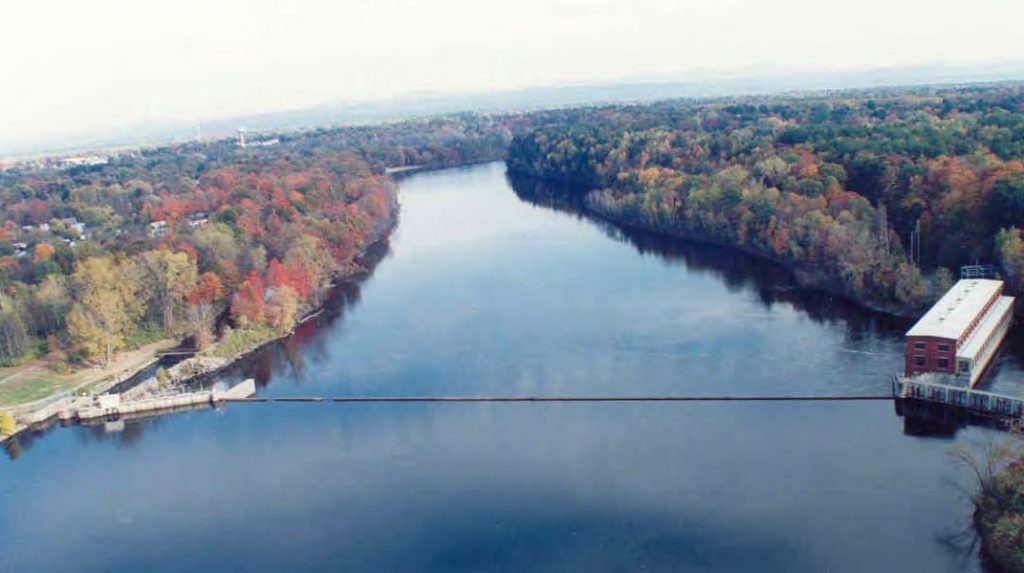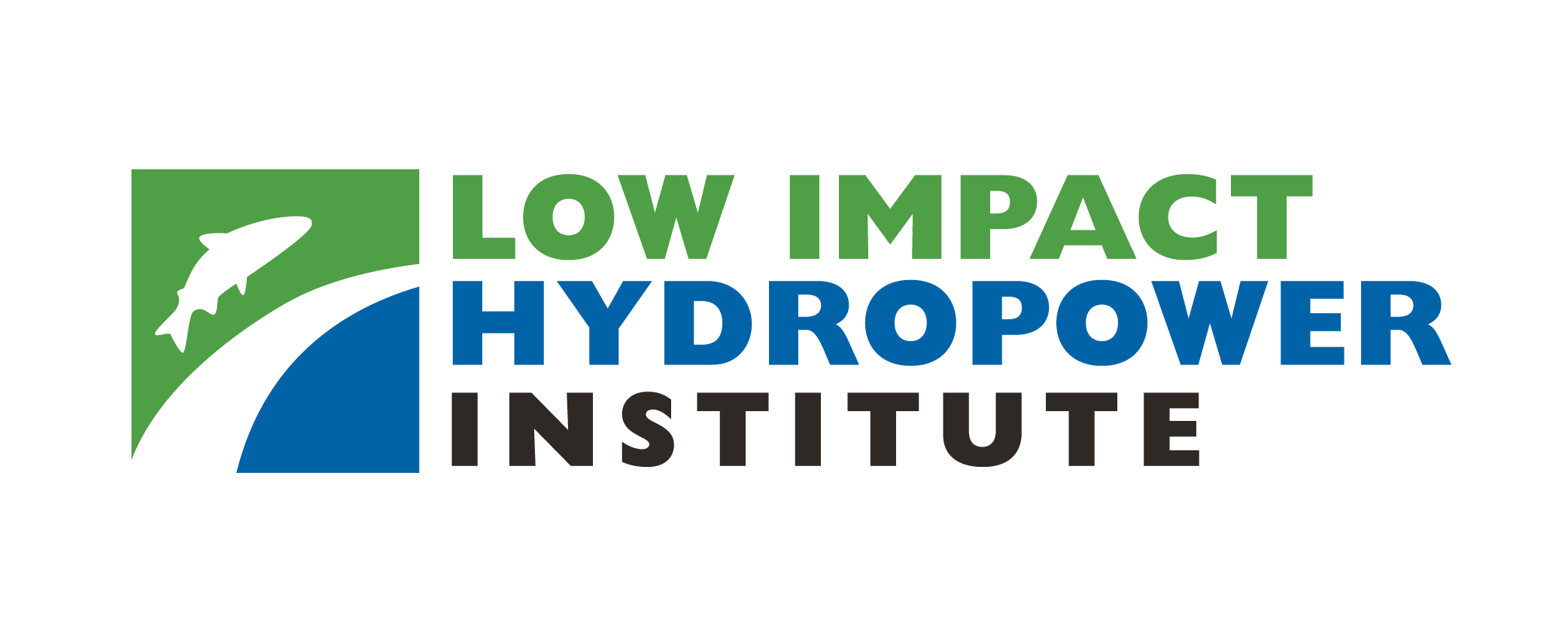Certificado LIHI #164 – Proyecto de presa alimentadora, Nueva York

| Nombre del proyecto | Alimentador Presa |
| Certificado LIHI No. |
164 |
| Plazo del certificado LIHI |
11 de junio de 2019 – 10 de junio de 2032 |
| Dueño | Erie Boulevard Hydropower, LP, una subsidiaria de Brookfield Renewable Energy Group |
| Estado | Nueva York |
| Ubicación | Milla fluvial 203 en el río Hudson |
| Capacidad instalada | 6 MW |
| Generación media anual | 25.173 MWh |
| Tipo de instalación | Pulsante |
| Comisión Federal de Comercio No. | P-2554 emitido en 2002, vence el 31/08/2042 |
El Proyecto de la Presa Alimentadora se ubica en el río Hudson, en los condados de Saratoga y Warren, Nueva York. El proyecto se construyó en 1828 y se modificó para la generación hidroeléctrica en 1924. Cuatro presas se encuentran aguas arriba, incluyendo Isla Sherman (LIHI #177), y diez presas se encuentran aguas abajo del proyecto, incluidas Cataratas Glens (LIHI #172)El embalse del proyecto es administrado por la Autoridad de Autopistas del Estado de Nueva York para garantizar el suministro de agua al Alimentador. Canal que facilita la navegación en el Canal Champlain, entre Fort Edward y el Lago Champlain. El proyecto es propiedad de Erie Boulevard Hydropower, LLC (Brookfield Renewable Energy Group).
El proyecto incluye una presa, antecámara, aliviadero, cerrado canal artificial, central eléctrica, y subestación.
La presa tiene 21 pies de altura y tres pies de profundidad. tableros de flashEl agua se transporta desde el cabecera estanque a través compuertas de entrada y hacia la cámara de carga de 76 metros de largo, pasando luego por un canal cerrado hasta las unidades generadoras. La central eléctrica contiene cinco turbinas de hélice vertical con una capacidad instalada total de 6 MW. El proyecto opera con un límite de fluctuación del embalse de 60 centímetros mientras el caudal del río se encuentre dentro del rango operativo de las turbinas. El límite de fluctuación del embalse se reduce a 30 centímetros del 1 de abril al 15 de junio para facilitar el desove de los peces.
El proyecto opera en modo pulsante como un proyecto de reregulación con un reservorio que comprende aproximadamente 717 acres en su nivel normal. Embargo Las fluctuaciones son estacionales y se limitan a 2 pies, excepto entre el 1 de abril y el 15 de junio, cuando se limitan a 1 pie. Los caudales diarios promedio mínimos son de 1760 pies cúbicos por segundo (cfs) por debajo de la presa y un caudal instantáneo. flujo base Se proporciona un caudal de 1500 pies cúbicos por segundo (cfs) debajo de la presa. Este régimen de caudal se desarrolló en consulta con el Departamento de Conservación Ambiental del Estado de Nueva York (NYSDEC).
Las aguas dentro del alcance del proyecto se clasifican como Clase B, hábitat adecuado para peces y recreación de contacto primario. También se consideran contaminadas por sedimentos contaminados con PCB, aunque el Departamento de Conservación Ambiental del Estado de Nueva York (NYSDEC) ha confirmado que esta contaminación no es causada por el proyecto.
Las presas aguas arriba y aguas abajo del proyecto no tienen paso de peces Medidas y bloqueo del acceso de especies migratorias de peces. La anguila americana ha estado presente previamente en el río y se ha observado que puede ascender las presas aguas abajo para llegar al proyecto, aunque solo se han avistado dos ejemplares (en 1984). Entre las especies residentes se incluyen la lobina de boca chica, la perca amarilla, la perca calabaza, la perca roca, el pez otoñal, el pez killi, el pez luna, el darter teselado, el lucio cadena y el pez gato negro. Basurero Las superposiciones con un espaciado de 1 pulgada y una descarga continua de 25 cfs reducen el potencial de arrastre de especies residentes.
Los terrenos del proyecto abarcan 679 acres. Los terrenos circundantes se encuentran en gran parte sin desarrollar, con algunas zonas de desarrollo residencial. La costa del embalse cuenta con algunas áreas de bosque y vegetación emergente. humedales.
PLUS-Estándar: El propietario del proyecto contribuye anualmente al Fondo de Mejora del Río Hudson/Sacandaga para la restauración del ecosistema, la repoblación pesquera y la gestión de los recursos naturales. También contribuye al Fondo de Mejora del Gran Lago Sacandaga, que también apoya la restauración del ecosistema, la repoblación pesquera, la gestión y la recreación en la cuenca. Asimismo, se realizan contribuciones al Fondo de Mejora de la Pesca para proyectos en todo el estado de Nueva York destinados a mejorar el hábitat fluvial, el acceso para la pesca con discapacidad, la restauración de especies nativas y la adquisición de derechos de pesca públicos.
Las especies amenazadas o en peligro de extinción potencialmente presentes en las inmediaciones del proyecto incluyen el murciélago orejudo norteño, el murciélago de Indiana, la mariposa azul de Karner y la mariposa enana escarchada. Tras consultar con la Oficina de Campo de Nueva York del USFWS y el Programa de Patrimonio Natural del NYSDEC, se concluyó que es improbable que el proyecto afecte a las especies incluidas en la lista. Se realizó un censo de la mariposa azul de Karner y la mariposa enana escarchada, pero no se observó ninguna. No se descubrió ningún hábitat crítico para el murciélago de Indiana en el área del proyecto, ni tampoco existe un hábitat crítico para el murciélago orejudo norteño. Podría haber ejemplares transitorios, y el proyecto planifica sus operaciones de acuerdo con la norma 4(d) del USFWS para la protección del murciélago orejudo norteño. Esta norma describe las disposiciones relacionadas con la preservación del hábitat forestal para la especie, especialmente en lo que respecta a la tala de árboles del 1 de junio al 31 de julio.
Las estructuras históricas dentro del alcance del proyecto incluyen la presa, la central eléctrica y el canal de alimentación. El proyecto opera bajo un plan de gestión de recursos culturales desarrollado en consulta con la Oficina Estatal de Preservación Histórica. El plan incluye disposiciones para garantizar la correcta gestión de los recursos históricos del proyecto.
Las instalaciones recreativas del proyecto incluyen un punto de estacionamiento para canoas debajo de la Presa Alimentadora, 16 plazas de aparcamiento para acceder al Canal Alimentador, estacionamiento para pesca en el canal de descarga, dos mesas de picnic en el Parque Overlook, una rampa para botes en la parte superior de un vehículo y un servicio de transporte y recogida de canoas. El acceso público es gratuito siempre que la seguridad y la propiedad privada no lo impidan.
Estado de cumplimiento
No existen condiciones específicas de la instalación en el Certificado actual
2025: No se identificaron cambios materiales ni problemas de cumplimiento. El proyecto sigue cumpliendo con los requisitos según la revisión anual.
2024: No se identificaron cambios materiales ni problemas de cumplimiento. El proyecto sigue cumpliendo con los requisitos según la revisión anual.
2023: No se identificaron cambios materiales ni problemas de cumplimiento. El proyecto sigue cumpliendo con los requisitos según la revisión anual.
2022: No se identificaron cambios materiales ni problemas de cumplimiento. El proyecto sigue cumpliendo con los requisitos según la revisión anual.
2021: No se informaron cambios ni problemas de cumplimiento. El proyecto sigue cumpliendo con los requisitos según la revisión anual.
2020: No se informaron cambios ni problemas de cumplimiento. El proyecto sigue cumpliendo con los requisitos según la revisión anual.
2019: La presentación de informes anuales para el Certificado actual aún no ha entrado en vigor.
Historial de certificaciones
1 de enero de 2022: El plazo del Certificado LIHI se ha extendido de acuerdo con la Revisión 2.05 del Manual de Certificación LIHI 2.ª Edición emitido el 1 de enero de 2022. Consulte la tabla de instalaciones anterior para conocer el nuevo plazo.
14 de octubre de 2019: La decisión de certificar el proyecto de la Presa Alimentadora es definitiva. No se recibieron solicitudes de apelación durante el período de apelaciones, que cerró el 12 de octubre de 2019. El proyecto, LIHI #164, tiene una vigencia del 11 de junio de 2019 al 10 de junio de 2027.
12 de septiembre de 2019: El Instituto de Energía Hidroeléctrica de Bajo Impacto (LIHI) ha aprobado preliminarmente la Certificación de Bajo Impacto para el Proyecto Hidroeléctrico de la Presa Alimentadora. Esta decisión es preliminar, a la espera del plazo de apelación de 30 días. Solo quienes presentaron comentarios sobre la solicitud inicial durante el plazo de 60 días pueden presentar una apelación. Dicha apelación debe incluir una explicación de por qué el Proyecto no cumple con los criterios de LIHI. Las solicitudes de apelación pueden enviarse por correo electrónico a comentarios@lowimpacthydro.org Con el asunto "Proyecto Hidroeléctrico de Presa Alimentadora", o por correo postal dirigido al Instituto de Energía Hidroeléctrica de Bajo Impacto, 329 Massachusetts Ave, Suite 6, Lexington, MA 02420. Todas las solicitudes se publicarán en el sitio web. El solicitante tendrá la oportunidad de responder, y cualquier respuesta también se publicará. Las solicitudes deben recibirse antes de las 5 p. m., hora del Este, el 12 de octubre de 2019. La solicitud completa y el informe de los revisores están disponibles a continuación. Si no se reciben solicitudes de apelación y la decisión es definitiva, el plazo de certificación del Proyecto (pendiente de LIHI #164) finalizará el 11 de junio de 2019 por un período de ocho (8) años, que expirará el 10 de junio de 2027.
12 de junio de 2019: El Instituto de Energía Hidroeléctrica de Bajo Impacto (LIHI) ha recibido una solicitud completa para la Certificación de Bajo Impacto del Proyecto Hidroeléctrico de la Presa Alimentadora. LIHI solicita comentarios públicos sobre esta solicitud. En concreto, nos interesa saber si considera que el Proyecto cumple con los Criterios de Certificación de Bajo Impacto de LIHI, revisados en la 2.ª edición del Manual. Por favor, revise el programa y los criterios en la versión revisada de LIHI. Manual y luego revise los materiales de solicitud del Proyecto a continuación. Los comentarios que estén directamente relacionados con criterios específicos de LIHI (flujos, calidad del agua, paso de peces, etc.) serán de gran ayuda, pero se considerarán todos los comentarios. Los comentarios pueden enviarse al Instituto por correo electrónico a comentarios@lowimpacthydro.org con “Comentarios sobre el Proyecto de Presa Alimentadora” en la línea de asunto, o por correo dirigido al Low Impact Hydropower Institute, 329 Massachusetts Avenue, Suite 6, Lexington, MA 02420. Los comentarios deben recibirse antes de las 5 p. m., hora del Este, el 11 de agosto de 2019. Se considerarán todos los comentarios. Se publicarán en el sitio web y el solicitante tendrá la oportunidad de responder. También se publicarán todas las respuestas.
Archivos de certificación
Certificación 2020
- Informe de revisión de la certificación de presas alimentadoras 2019
- Solicitud de certificación de presas de alimentación 2019
